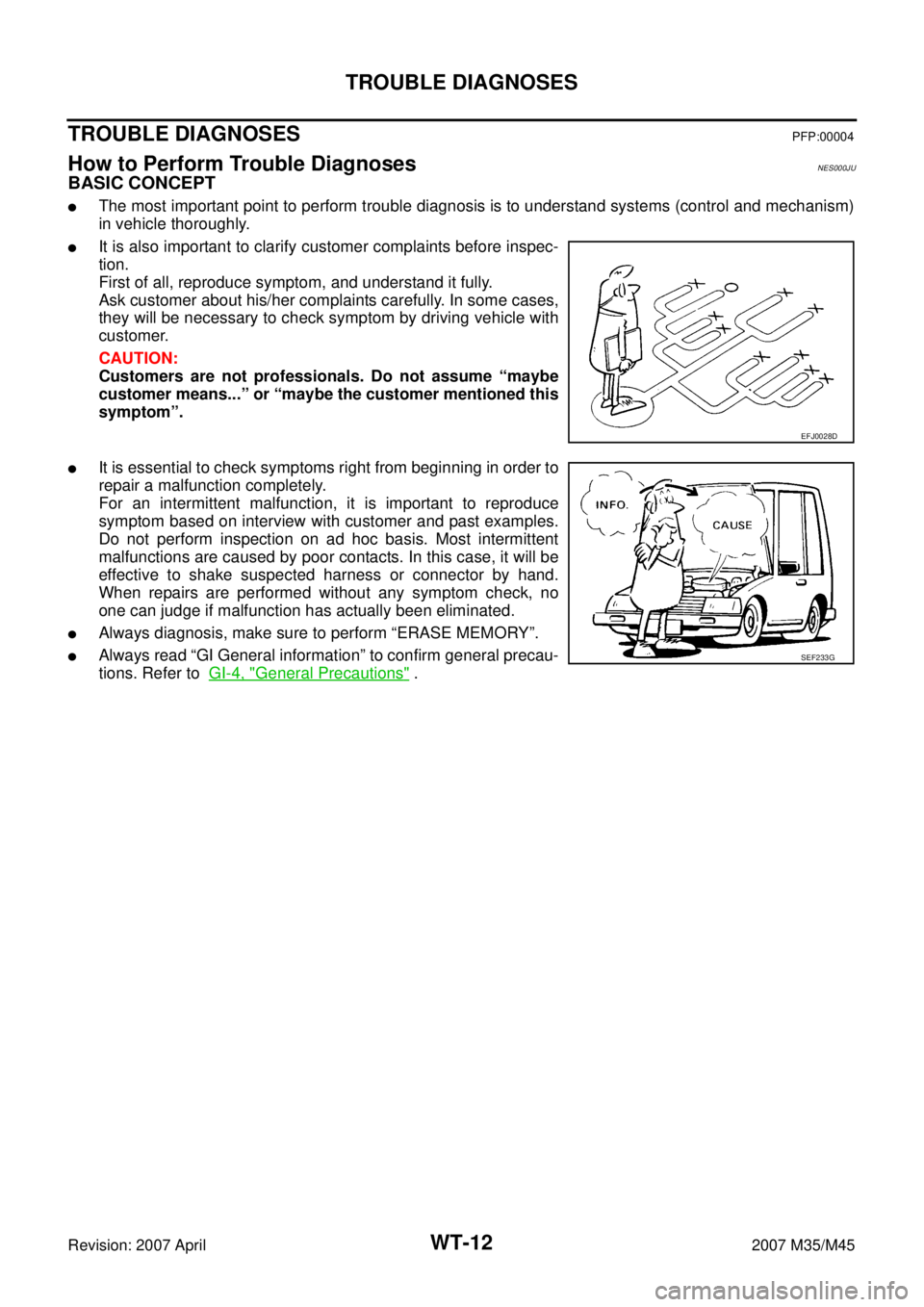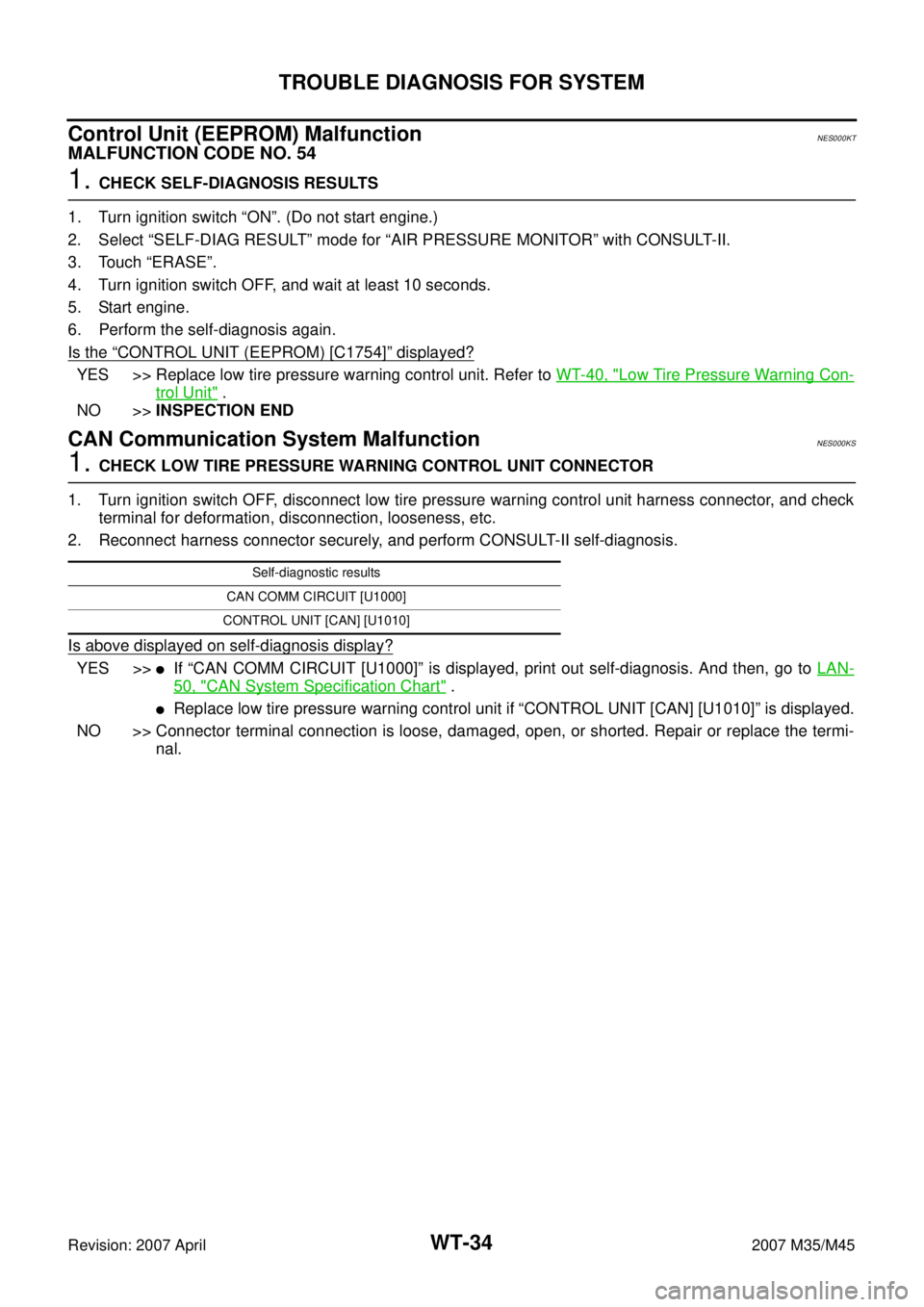Page 4561 of 4647

WT-12
TROUBLE DIAGNOSES
Revision: 2007 April2007 M35/M45
TROUBLE DIAGNOSESPFP:00004
How to Perform Trouble DiagnosesNES000JU
BASIC CONCEPT
�The most important point to perform trouble diagnosis is to understand systems (control and mechanism)
in vehicle thoroughly.
�It is also important to clarify customer complaints before inspec-
tion.
First of all, reproduce symptom, and understand it fully.
Ask customer about his/her complaints carefully. In some cases,
they will be necessary to check symptom by driving vehicle with
customer.
CAUTION:
Customers are not professionals. Do not assume “maybe
customer means...” or “maybe the customer mentioned this
symptom”.
�It is essential to check symptoms right from beginning in order to
repair a malfunction completely.
For an intermittent malfunction, it is important to reproduce
symptom based on interview with customer and past examples.
Do not perform inspection on ad hoc basis. Most intermittent
malfunctions are caused by poor contacts. In this case, it will be
effective to shake suspected harness or connector by hand.
When repairs are performed without any symptom check, no
one can judge if malfunction has actually been eliminated.
�Always diagnosis, make sure to perform “ERASE MEMORY”.
�Always read “GI General information” to confirm general precau-
tions. Refer to GI-4, "
General Precautions" .
EFJ0028D
SEF233G
Page 4570 of 4647

TROUBLE DIAGNOSES
WT-21
C
D
F
G
H
I
J
K
L
MA
B
WT
Revision: 2007 April2007 M35/M45
NOTE:
Before performing the self-diagnosis, be sure to register the ID, or else the actual malfunction location may be different from that dis-
played on CONSULT-II.
NOTICE:
182 kPa (1.82 kg/cm
2 , 26.5 psi): Standard air pressure is for 230 kpa (2.3 kg/cm2 , 33 psi) vehicles.
How to Erase Self-Diagnostic Results
1. Perform applicable inspection of malfunctioning item and then repair or replace.
2. Start engine, and touch “START (NISSAN BASED VHCL)” “AIR PRESSURE MONITOR” “SELF-DIAG
RESULTS” “ERASE” in this order to erase the diagnostic memory.
CAUTION:
If memory cannot be erased, repeat step 1, 2.
3. Perform self-diagnosis again, and make sure that DTC memory is erased.
DATA MONITOR MODE
Operation Procedure
1. Perform “CONSULT-II Start Procedure”. Refer to GI-38, "CONSULT-II Start Procedure" .
2. Touch “DATA MONITOR”.
3. Select from “SELECT MONITOR ITEM”, screen of data monitor is displayed.
NOTE:
When malfunction is detected, CONSULT-II performs REAL-TIME DIAGNOSIS. Also, any malfunction
detected while in this mode will be displayed in real time.
Display Item List
NOTE:
Before performing the self-diagnosis, be sure to register the ID, or else the actual malfunction location may be different from that dis-
played on CONSULT-II.MONITOR CONDITION SPECIFICATION
VEHICLE SPEED SE Drive vehicle. Vehicle speed (km/h or MPH)
AIR PRESS FL
AIR PRESS FR
AIR PRESS RR
AIR PRESS RL
�Drive vehicle for a few minutes.
Tire pressure (kPa or Psi) or
�Ignition switch ON and activation tool is
transmitting activation signals.
ID REGST FL
ID REGST FR
ID REGST RR
ID REGST RL
Ignition switch ONRegistration ID: DONE
No registration ID: YET
WARNING LAMPLow tire pressure warning lamp on: ON
Low tire pressure warning lamp off: OFF
BUZZERBuzzer in combination meter on: ON
Buzzer in combination meter off: OFF
Page 4583 of 4647

WT-34
TROUBLE DIAGNOSIS FOR SYSTEM
Revision: 2007 April2007 M35/M45
Control Unit (EEPROM) MalfunctionNES000KT
MALFUNCTION CODE NO. 54
1. CHECK SELF-DIAGNOSIS RESULTS
1. Turn ignition switch “ON”. (Do not start engine.)
2. Select “SELF-DIAG RESULT” mode for “AIR PRESSURE MONITOR” with CONSULT-II.
3. Touch “ERASE”.
4. Turn ignition switch OFF, and wait at least 10 seconds.
5. Start engine.
6. Perform the self-diagnosis again.
Is the
“CONTROL UNIT (EEPROM) [C1754]” displayed?
YES >> Replace low tire pressure warning control unit. Refer to WT-40, "Low Tire Pressure Warning Con-
trol Unit" .
NO >>INSPECTION END
CAN Communication System MalfunctionNES000KS
1. CHECK LOW TIRE PRESSURE WARNING CONTROL UNIT CONNECTOR
1. Turn ignition switch OFF, disconnect low tire pressure warning control unit harness connector, and check
terminal for deformation, disconnection, looseness, etc.
2. Reconnect harness connector securely, and perform CONSULT-II self-diagnosis.
Is above displayed on self-diagnosis display?
YES >>�If “CAN COMM CIRCUIT [U1000]” is displayed, print out self-diagnosis. And then, go to LAN-
50, "CAN System Specification Chart" .
�Replace low tire pressure warning control unit if “CONTROL UNIT [CAN] [U1010]” is displayed.
NO >> Connector terminal connection is loose, damaged, open, or shorted. Repair or replace the termi-
nal.
Self-diagnostic results
CAN COMM CIRCUIT [U1000]
CONTROL UNIT [CAN] [U1010]